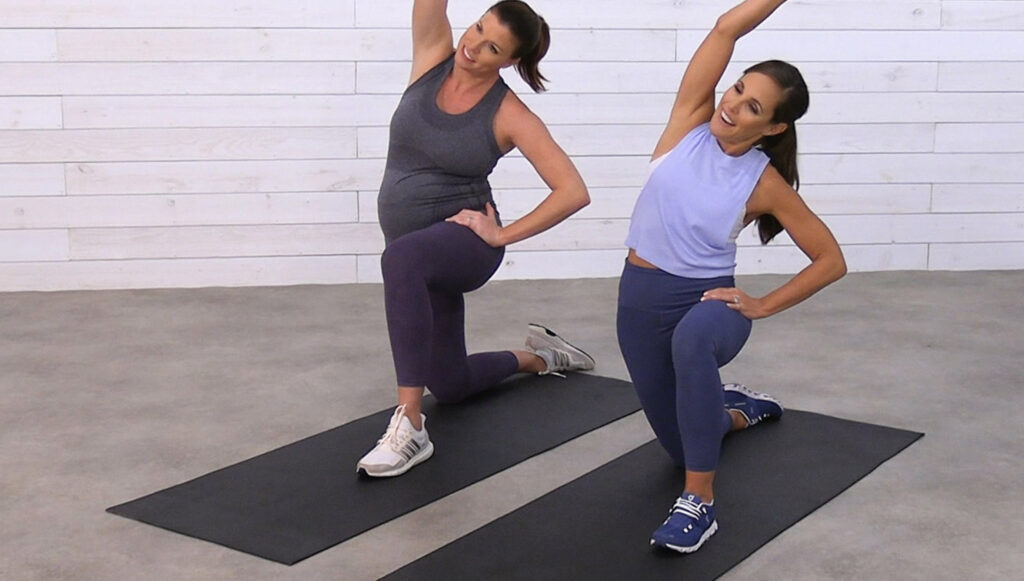
Imagine the load your back, spine, and abdominal areas take on as your belly grows. The muscles surrounding these areas take a lot of strain and sometimes pain is inevitable. 50% of low back pain in pregnant women is due to lumbar lordosis, otherwise known as swayback. As you move(d) into the 2nd and 3rd trimesters, the abdominal muscles stretch and lose their ability to effectively maintain neutral posture. Although back pain is common during pregnancy and postpartum, some muscle imbalances happen chronically over time, over years.
Did you know that more than 60% of women have back pain? And, more often than not, back pain (as well as other pain) is due to a weak core. Your core is more than just your abs; it comprises all the muscles of your including the glutes. In our pregnancy workouts, you will find that several exercises concentrate on your glutes as part of the core work, especially in the postpartum period when we are readjusting back to that anterior pelvic tilt, as the top of your pelvis tilts forward during pregnancy and your upper spine tends to round. Hence, in our pregnancy workouts, we will strengthen and stretch all of the muscles around the spine, with a specific focus on the glutes and the abs.
Another condition that our pregnancy workouts are designed to correct is Lordosis, or swayback. Lordosis, or an excessive inward curvature of the spine, chronically happens over time, but is accentuated during pregnancy due to the growing belly and the relaxing of the ligaments in the pelvis. In order to counterbalance the effects of lordosis and kyphosis, the outward curvature of the spine which is more prominent after pregnancy, we concentrate on strengthening the glutes, abdominals and muscles of the upper back, such as the rhomboids and trapezius. Additionally, we will help with your flexibility by providing proper stretches for the lower back and hip flexors, which need to be lengthened during pregnancy and beyond.
It’s important that you both strengthen and stretch to improve back pain!
Strengthen – abdominals, muscles along the spine, upper back and hip extensors
*Use this simple move for the transverse abdominis to start combating back pain right now!
Stretch – lower-middle-upper back, hip flexors and chest
With your increase in weight and the fact that you are “frontloaded” you may begin to experience even greater soreness. If your boobs double and triple in size you may get even more back pain, and pain during exercise. Your core muscles act as a back brace, so back and abdominal strengthening is key, as well as stretching.
Postpartum back pain is somewhat common. As a new mother, your ligaments and joints are still recovering from the stretching that your baby in utero forced them to undergo. Add the sensitivity of these overworked parts to the increased lifting, twisting, and sometimes awkward cradling that motherhood calls for (sometimes the position that baby falls asleep in, mom stays in, regardless of mom’s comfort!), and a soreness and tension in the shoulders, back, and hips is guaranteed.
I’m going to disappoint most of you and start out by saying there is absolutely no one exercise you can do to cure low back pain. There, I have said it. Gosh I wish I had a magic wand to bibidi-bobidi-boo back pain away. There is a reason back pain costs BILLIONS of dollars to treat each year. Back pain can be complicated and down right yucky (highly educated description).
However, if you are consistent with retraining your core muscles and practice good posture and body mechanics, you can dramatically decrease your back pain and can even go a long way to preventing back pain. Start out by getting the Transverse Abdominis and Pelvic Floor firing — and then add in exercises to strengthen you back, deep hip rotators and gluts.
We have excellent resources and core workouts to help your back pain. These workout videos are great at incorporating key muscle groups. If you do have back pain and are finding that consistency with your core program is not getting rid of the pain, please get in touch with a physical therapist. You are probably getting tired of me recommending this, but physical therapists are movement specialists and can help determine the exact cause/driver of your back pain. Often back pain is just a symptom of the problem, and a PT can help you get to the root of the issue.
Overall, simple postural cues and keeping a neutral spine position throughout daily activities will take you a long way! Simply using the stomach muscles will immediately lessen the strain on your back.
Along with bending at the knees instead of the hips when lifting, you should also consider switching sides each time you feed or hold your child, whether whether you are nursing or bottle-feeding.
It is key to check your foot alignment, because if foot alignment is askew, it can throw off the knees, the hips, the back, the shoulders, and the neck. Specifically, look for pronated feet (they roll inwards) or supinated feet (they roll outwards) when you walk or jog.